Project Triangle Strategy Demo - Four Things I Love and Two I'm Unsure About after two runs through the demo
When Project Triangle Strategy was announced with a playable demo during last week's Nintendo Direct, my interest was immediately piqued. Strategy RPGs have always been one of my favorite genres of video games, with Fire Emblem titles typically topping my lists of favorite games for any given year (see my personal 2019 list, for instance). A new strategy RPG in the HD-2D vein of Octopath Traveler is something I never knew I wanted until, well, last week.
During the announcement of Project Triangle Strategy -- a title which I enjoy typing out again due to how ludicrously clumsy it is -- a large focus of the presentation was given to divergent narrative branches through the 'Scales of Conviction' mechanic. This immediately springs to mind the likes of Tactics Ogre, a similar isometric strategy game of which non-linear narrative progressive is a hallmark. However, several RPGs come out of the gate shouting about their supposed focus on 'Choices and Consequences', enough so that I find myself slightly sneering at the banality of the phrase. However, after two playthroughs of the new demo, I find myself pretty damned optimistic that perhaps there is some significant merit to it here.
Here are four things I found myself loving after my time with the demo, alongside two I hope are tweaked before release next year.
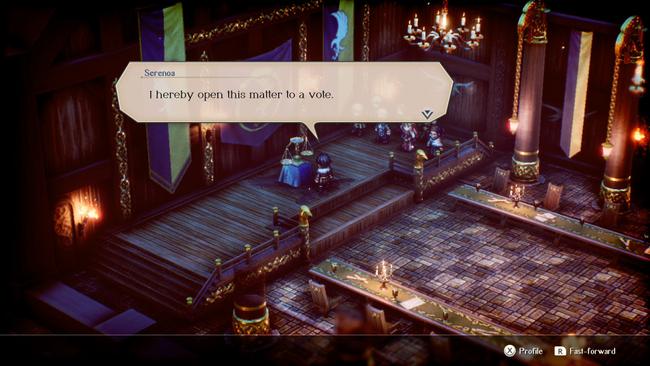
Four Things I Like
-
Real Consequences to Decisions
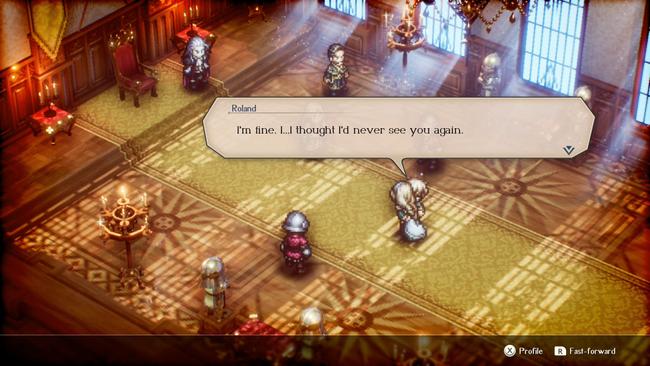
Project Triangle Strategy's demo is worth playing twice, it really is. Pulled from the middle of the game, specifically Chapters VI and VII, the demo here really does feel like a vertical slice of the final product. While this means that some of the story's context is admittedly foggy and some of the framework has to be gleaned, I think it does do a solid job of establishing the major players, identifying the setting, and giving a nice glimpse into the wider conflict at play.
To set the stage a bit: the demo consists of the aforementioned two chapters, a major decision made between them regarding sheltering the young Prince Roland, and some side story events to view as well. On my first time through, I made the choice that I felt was appropriate -- to defend the prince with my life, of course. However, I found myself feeling significantly more impressed once I played through a second time and deliberately making the other choice presented to the player: to give up the prince and play for the long game, having bargained for safety.
You see, depending on the choice made between the two chapters, I found myself on a significantly divergent story thread in the second half of my second time through the demo. The battle took place in a different location, with a different objective and a different context. In fact, the entire tonality of the demo's second chapter immediately felt different. On top of that, I had a different character join my ranks with a unique backstory all of his own. Most surprisingly, I was treated to different side-story events to view, with some introducing characters and locations that my first playthrough did not even touch on. The fact that the level of branching present here in a two-chapter segment is so significant is enough to really give me confidence that when the phrase "Consequences" is used in the marketing here, it seems to earnestly mean it.
-
A Strong Emphasis on Support and Sabotage
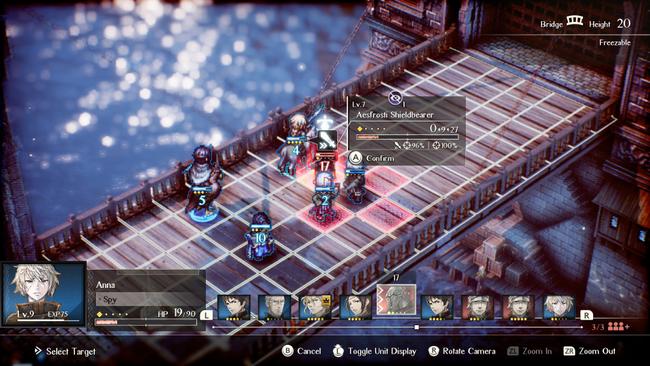
On a pure gameplay front, Triangle Strategy is a very familiar romp to anyone that's played any amount of Ogre Battle, Final Fantasy Tactics, Fire Emblem, or the like. Units are deployed onto starting locations on a grid, and turn-wise approach and defeat enemy units while attempting to complete some objective. Units can undertake one movement and typically one action: whether it's an attack, using an item, or casting a spell, or such. After each turn, you'll choose a direction to face -- being attacked from behind means you'll take more damage and you'll deal more when used against an enemy. It's typical strategy fare, well-worn and not all that novel in this respect.
However, I found myself pleasantly surprised and just how much variety there was in terms of the capabilities of my units. While having melee units, ranged units, casters, and healers is pretty much expected of any game like this, I found that Triangle Strategy goes one appreciated step further and showcases it well. My healer can also hasten other units, my ice mage can choke off enemies with walls of ice, while my fire mage can allow any ally to counterattack with a buff. Other units can blind or put foes to sleep, root them in place, or delay their next turn. Pretty much none of the original assortment of characters focuses purely on depleting enemy HP from full to zero -- properly utilizing map layouts, debilitating conditions, combo attacks, and the like is key to a comfortable victory. While having these sorts of options might be considered basic necessities for a quality strategy RPG, the fact that it's already prevalent here to such an extent presumably early in the game and with a limited cast is incredibly promising.
-
It's No Push-over
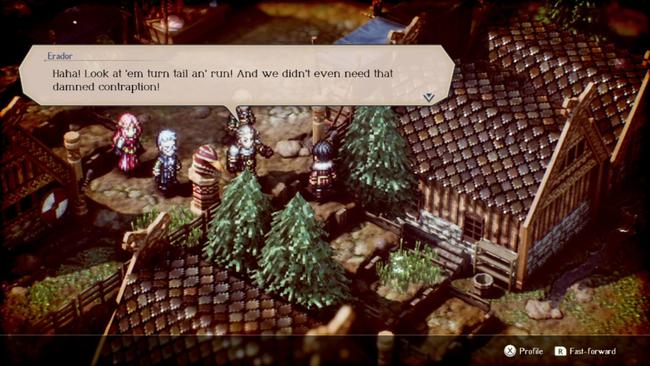
Despite being a demo, I found myself a bit surprised at the level of challenge present here. Tied to the above point, players that don't make use of each unit's bespoke abilities might find themselves struggling a tad, especially on the second of the two fights (in both versions of the chapter). While the initial level on the bridge serves as a nice comfortable teaching tool for most of the game's systems, I find myself wondering if players new to strategy games might find the later part of the demo a bit of a turn-off. However, I personally enjoyed being surprisingly tested and implementing some actual strategy in the back-half here. Triangle Strategy doesn't seem to have any sort of permadeath or death penalty feature which eases up the tension a fair bit, but I found myself playing as somewhat of a perfectionist anyway, and restarted the later battle if a unit took too much damage. I've played enough classic Fire Emblem for it to be second nature, I suppose.
One thing that I found interesting here is that in one of the later battles, the player is given an option to burn down civilian buildings as a useful trap to take out several enemy units. The noble soul that I am decided I was going to forgo using such a cowardly and dangerous method and decided to complete the chapter without resorting to such tactics. While this was a personal challenge I placed on myself that I was happy to engage in for challenge's sake, the game itself also recognized this feat and slightly shifted the outcome of the battle's cutscenes to reflect the achievement. The possibility of being able to permute the plot's direction by both utilizing out-of-battle decisions and in-battle tactics is something I hope the final game endeavors to accomplish.
-
The TP and Quietus Systems
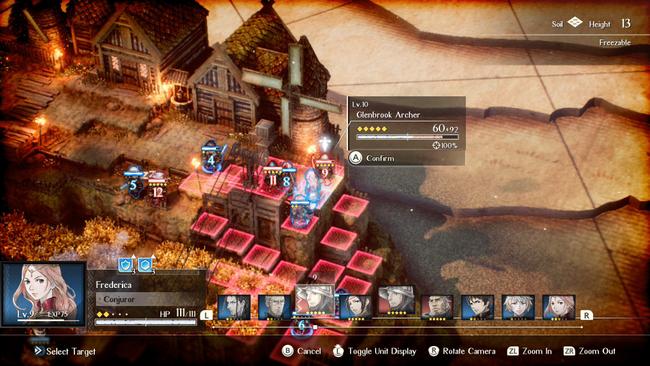
This one's a bit more in the weeds, but two specific systems I'm really enjoying about the demo here is that of Tactical Points, or TP, as well as the Quietus System. Instead of having some sort of Mana or MP pool, all units begin each battle with one point of TP, which can cap out at a max of 5. Some units will have passive skills which will award them extra TP in certain instances, such as when defeating an enemy unit with a spell it's weak to or such. All units will earn an extra point of TP each turn, allowing players to build up their pool or spend extra on more powerful attacks -- it's easy to see the inspiration from Octopath Traveler here, though other strategy games have used ramp-like mechanics with their MP or similar systems.
The fact that TP points max at 5 brings about a smart economy that feels like it'll prevent the system from becoming negligible, and abilities and spells will always be able to account for this fixed action pool no matter how strong a unit gets. It means support units that are able to grant a single extra TP to an ally immediately become (and should stay) pretty valuable, for instance. The demo also allows the player to use an anytime-use spell called a Quietus to restore a whopping 2 TP to any unit whenever they want.
Quietuses (Quieti?) are incredibly reminiscent of the deck of spells used in Fae Tactics (another great tactical RPG!) where collecting new and powerful spell cards was a major mechanic. It even shows up here in the demo, where the encampment merchant will sell players a new one in exchange for Kudos, another system I haven't even touched on. You earn those by attacking enemies from behind or using abilities they're weak to, or the like. Altogether, the systems seem smartly-made, appropriately integrated, and I'm excited to see what some of the more powerful Quietuses or 5-TP abilities are waiting to be shown in the full release.
Two Things I'm Unsure About
-
Voice Acting
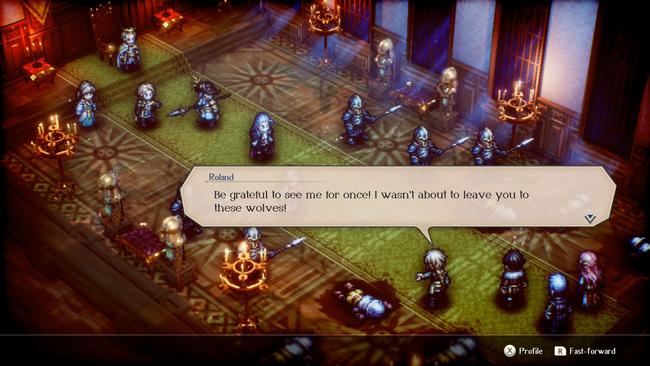
While I'm invested in the story presented in the demo, one hurdle that I keep finding myself tripping over is a pretty major one: the voice-acting. I typically find myself pretty insensitive to these sort of things. Usually, even an average or unremarkable set of vocal performances is fine to me as long as the narrative underneath is compelling. However, even with my tolerance to subpar voice-acting, I found myself unsold on much of what's showcased in the demo here. The worst of it is that many of the major characters seem to have more uneven performances than some of the side characters -- though maybe I just latched onto them because they had more lines to critique.
It's a shame because I actually feel that the snippet of wider plot elements introduced here are encouraging and have some potential. It might be too late to hope things are improved before next year's release. At the moment, the best remedy is potentially to simply shift the voice volume slider all the way to mute most voices entirely and really lean into the nostalgia of our favorite SRPGs of yesteryear.
-
Uneven Graphical Style
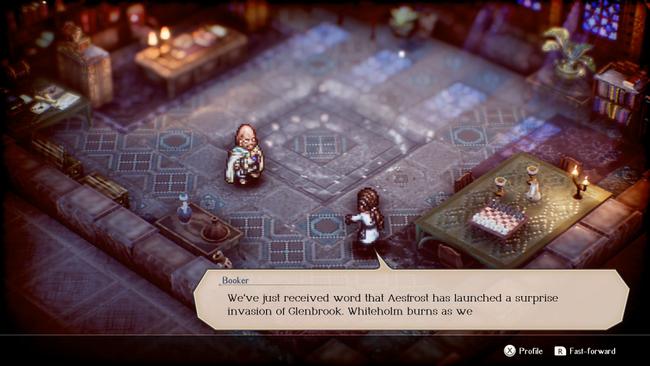
At times, Project Triangle Strategy looks gorgeous. Spell animations, the character sprites in general, even the UI and interface are all well presented and should be a highlight of the game. It's a major reason Octopath Traveler made the splash that it did. However, also similar to Octopath, there are some cases where I feel that the modern engine and processing effects and the more classically styled look of the game are at odds. It's more apparent in motion, but sometimes I feel that a few of the effects could be toned down to create a cleaner-looking game overall.
In the image above, a Depth-of-Field style effect is applied to the objects in the back of the room when the character on the right is talking, but this effect is moved away when he is given a response by the character on the left. Sometimes this sort of oddity is exacerbated as the camera slowly shifts back and forth in an effort to create a sort of dynamic effect in some of the heavier scenes. Occasionally lighting and vignetting effects also feel applied too liberally and I end up feeling like I'm playing the game through a poorly-washed window. While Octopath Traveler had a few options to tweak these settings a tiny bit, I hope that some of these end up being configurable in the final game here. It's a nitpick for sure, but I personally feel that the sprite-based art style, character portraits, and HD-2D environments are enough to carry the game, and the processing effects simply muddy the result.
Overall, I found myself quite impressed after two playthroughs through this new demo, and I can't stress enough how seeing the results of that subsequent run-through really did matter. If you've played through the demo already and ended up feeling lukewarm on it (or hell, even positive), I encourage you to try one more time through.